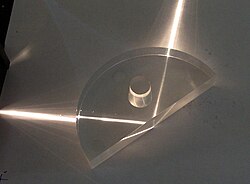Total Internal Reflection
Total internal reflection is an optical phenomenon that occurs when a ray of light strikes a medium boundary at an angle larger than the critical angle with respect to the normal to the surface. If the refractive index is lower on the other side of the boundary no light can pass through, so effectively all of the light is reflected. The critical angle is the angle of incidence above which the total internal reflection occurs.
When light crosses a boundary between materials with different refractive indices, the light beam will be partially refracted at the boundary surface, and partially reflected. However, if the angle of incidence is greater (i.e. the ray is closer to being parallel to the boundary) than the critical angle — the angle of incidence at which light is refracted such that it travels along the boundary — then the light will stop crossing the boundary altogether and instead be totally reflected back internally. This can only occur where light travels from a medium with a higher refractive index to one with a lower refractive index. For example, it will occur when passing from glass to air, but not when passing from air to glass.
Optical description

Total internal reflections can be demonstrated using a semi-circular glass block. A "ray box" shines a narrow beam of light (a "ray") onto the glass. The semi-circular shape ensures that a ray pointing towards the centre of the flat face will hit the curved surface at a right angle; this will prevent refraction at the air/glass boundary of the curved surface. At the glass/air boundary of the flat surface, what happens will depend on the angle. Where θc is the critical angle (measured normal to the surface):
- If θ < θc, as with the red ray in the above figure, the ray will split. Some of the ray will reflect off the boundary, and some will refract as it passes through.
- If θ > θc, as with the blue ray, the entire ray reflects from the boundary. None passes through. This is called total internal reflection.
This physical property makes optical fibers useful, and rainbows and prismatic binoculars possible. It is also what gives diamonds their distinctive sparkle, as diamond has an extremely high refractive index.
The Critical angle
The critical angle is the angle of incidence above which total internal reflection occurs. The angle of incidence is measured with respect to the normal at the refractive boundary. The critical angle <math>\theta_c</math> is given by:
- <math>\theta_c = \arcsin \left( \frac{n_2}{n_1} \right), </math>
where <math>n_2</math> is the refractive index of the less dense medium, and <math>n_1</math> is the refractive index of the denser medium.
If the incident ray is precisely at the critical angle, the refracted ray is tangent to the boundary at the point of incidence. If for example, visible light were traveling from a glass (i.e. Lucite with an index of refraction of 1.50) into air (with an index of refraction of 1.00). The calculation would give the critical angle for light from Lucite into air, which is
- <math>\theta _{c}=\arcsin \left( 1.00/1.50 \right)=41.8{}^\circ </math>.
Light incident on the border with an angle less than 41.8° would be partially transmitted, while light incident on the border at larger angles with respect to normal would be totally internally reflected.
The critical angle for diamond in air is about 24.4°, which means that light is much more likely to be internally reflected within a diamond. Diamonds for jewelry are cut to take advantage of this; in particular the brilliant cut is designed to achieve high total reflection of light entering the diamond, and high dispersion of the reflected light (known to jewelers as fire).
If the fraction: <math>\frac{n_2}{n_1}</math> is greater than 1, then arcsine is not defined--meaning that total internal reflection does not occur even at very shallow or grazing incident angles.
So the critical angle is only defined for <math>\frac{n_2}{n_1}\leq1</math>.
Evanescent wave
An important side effect of total internal reflection is the propagation of an evanescent wave across the boundary surface. Essentially, even though the entire incident wave is reflected back into the originating medium, there is some penetration into the second medium at the boundary. This wave can lead to a phenomenon known as frustrated total internal reflection. Additionally, the evanescent wave appears to travel along the boundary between the two materials, leading to the Goos-Hänchen shift.
Frustrated total internal reflection
Under "ordinary conditions" it is true that the creation of an evanescent wave does not affect the conservation of energy, i.e. the evanescent wave transmits zero net energy. However, if a third medium with a higher refractive index than the second medium is placed within less than several wavelengths distance from the interface between the first medium and the second medium, the evanescent wave will be different from the one under "ordinary conditions" and it will pass energy across the second into the third medium. (See evanescent wave coupling.)
A transparent, low refractive index material is sandwiched between two prisms of another material. This allows the beam to "tunnel" through from one prism to the next in a process very similar to quantum tunneling while at the same time altering the direction of the incoming ray.
Applications
- Optical fibers, which are used in endoscopes and telecommunications.
- Rain sensors to control automatic windscreen/windshield wipers.
- Another interesting application of total internal reflection is the spatial filtering of light.[1]
- Multi-touch screens [1] use frustrated total internal reflection in combination with a camera and appropriate software to pick up multiple targets.
- Gonioscopy to view the anatomical angle formed between the eye's cornea and iris.
- Gait analysis instrument, CatWalk [2], use frustrated total internal reflection in combination with a high speed camera to capture and analyze footprints of laboratory rodents.
Examples in everyday life
Total internal reflection can be observed while swimming, if one opens one's eyes just under the water's surface. If the water is calm, its surface appears mirror-like.
One can demonstrate total internal reflection by filling a sink or bath with water, taking a glass tumbler, and placing it upside-down over the plug hole (with the tumbler completely filled with water). While water remains both in the upturned tumbler and in the sink surrounding it, the plug hole and plug are visible since the angle of refraction between glass and water is not greater than the critical angle. If the drain is opened and the tumbler is kept in position over the hole, the water in the tumbler drains out leaving the glass filled with air, and this then acts as the plug. Viewing this from above, the tumbler now appears mirrored because light reflects off the air/glass interface.
Another very common example of Total Internal Reflection is a critically cut diamond. This is what gives it maximum sparkle.
See also
- Evanescent wave
- Perfect mirror
- Refraction
- Refractive index
- Fresnel equations
- Snell's window
- Goos-Hänchen effect


